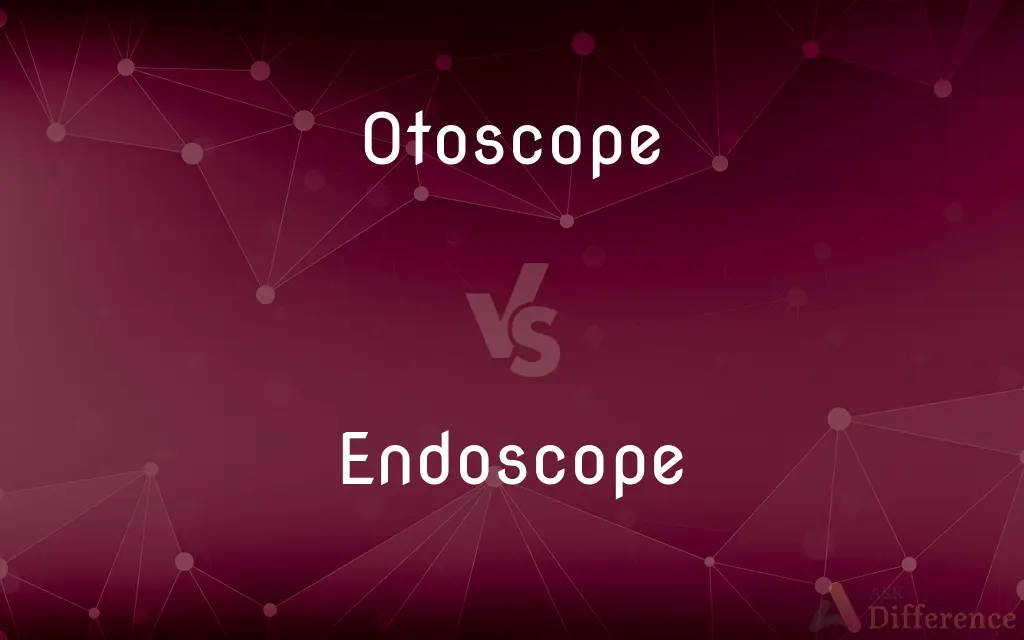Otoscope vs. Endoscope — What's the Difference?
By Fiza Rafique & Maham Liaqat — Updated on March 27, 2024
An otoscope is specifically designed for examining the ear canal and eardrum, whereas an endoscope is a more versatile tool used to view the interior of a body cavity or organ.

Difference Between Otoscope and Endoscope
Table of Contents
ADVERTISEMENT
Key Differences
While otoscopes are primarily used by otolaryngologists (ENT specialists), pediatricians, and general practitioners for ear-related diagnoses, endoscopes are utilized across various medical specialties, including gastroenterology for colonoscopies and upper GI tract examinations, pulmonology for examining the lungs, and urology for inspecting the urinary tract. This highlights the otoscope's specialized use compared to the endoscope's broad application in medical diagnostics and treatments.
The design and functionality of otoscopes are straightforward, focusing on providing a clear view of the ear canal and tympanic membrane. Endoscopes, however, are more complex, often integrated with additional instruments that can perform tasks such as taking tissue samples (biopsies), removing foreign objects, or even conducting surgical procedures like removing tumors or polyps. This complexity makes endoscopes more versatile but also significantly more expensive and requiring more training to use effectively.
In terms of technological advancement, endoscopes have seen significant innovations, including the development of video endoscopes, which project the camera's view onto a screen, providing a clearer and more detailed image. Some endoscopes also offer features like adjustable flexibility, suction capabilities, and the ability to deliver laser treatments. While otoscopes have also benefited from technological improvements, such as digital imaging and better illumination technologies, their advancements are more focused on enhancing visual clarity and comfort during ear examinations.
Despite these differences, both otoscopes and endoscopes play crucial roles in modern medicine, enabling doctors to conduct thorough examinations, make accurate diagnoses, and carry out targeted treatments with minimal discomfort to patients. Their use underscores the importance of visual examination in healthcare, providing valuable insights into the body's internal state and functioning.
Comparison Chart
Purpose
Examining the ear canal and eardrum.
Viewing the interior of body cavities or organs.
ADVERTISEMENT
Use
Diagnosing ear conditions.
Diagnostic and surgical procedures.
Specialization
Ear health.
Multiple medical fields.
Design
Light and magnifying lens.
Flexible or rigid tube with light and camera.
Functionality
Visual inspection of the ear.
Visual inspection, biopsies, surgical procedures.
Technological Advancements
Digital imaging, enhanced illumination.
Video projection, adjustable flexibility, surgical tools.
Compare with Definitions
Otoscope
A medical device for ear examination.
The doctor used an otoscope to check for signs of infection in the patient's ear.
Endoscope
Used across various specialties.
Gastroenterologists, pulmonologists, and urologists rely on endoscopic technology.
Otoscope
Advances focus on improving examination accuracy.
Modern otoscopes offer clearer images, aiding better diagnosis.
Endoscope
Continuously evolving for better patient care.
New endoscope models feature enhanced imaging and flexibility for safer procedures.
Otoscope
Compact and straightforward in design.
The otoscope's design makes it easy to inspect the narrow ear canal.
Endoscope
Allows for internal examination of the body.
The surgeon used an endoscope to explore the abdominal cavity.
Otoscope
Often used in routine check-ups.
Pediatricians regularly use otoscopes during children's health visits.
Endoscope
Versatile in medical diagnostics and surgery.
Endoscopes are crucial for procedures like colonoscopies and biopsies.
Otoscope
Essential for diagnosing common ear problems.
Otoscopes help identify issues like earwax buildup and eardrum perforations.
Endoscope
Integrated with technology for complex tasks.
Advanced endoscopes can remove polyps or deliver treatments.
Otoscope
An otoscope or auriscope is a medical device which is used to look into the ears. Health care providers use otoscopes to screen for illness during regular check-ups and also to investigate ear symptoms.
Endoscope
An endoscope is an illuminated optical, typically slender and tubular instrument (a type of borescope) used to look deep into the body and used in procedures called an endoscopy. Endoscopes use tubes which are only a few millimeters thick to transfer illumination in one direction and high-resolution images in real time in the other direction, resulting in minimally invasive surgeries.
Otoscope
An instrument designed for visual examination of the eardrum and the passage of the outer ear, typically having a light and a set of lenses.
Endoscope
A slender, tubular instrument, such as an arthroscope or laparoscope, that is inserted into a body cavity or part for the purpose of visual examination, diagnosis, or surgical treatment.
Otoscope
An instrument for examining the interior of the ear, especially the eardrum, consisting essentially of a magnifying lens and a light.
Endoscope
An instrument used to examine a bodily orifice or canal, or a hollow organ.
Otoscope
(medicine) An instrument used for examining the eardrum and interior of the outer ear.
Endoscope
An instrument for examining the interior of the body, consisting of a flexible tube with lenses and optical fibers permitting illumination of the interior site to be inspected, and visualization of the interior site from outside the body; it often has small surgical instruments attached to the end and manipulable from the outside, permitting biopsy or surgery. It is used as a non-invasive or minimally invasive tool for diagnosis or treatment, especially in organs having an external opening such as the rectum, the urethra, and the bladder.
Otoscope
An instrument for examining the condition of the ear.
Endoscope
A long slender medical instrument for examining the interior of a bodily organ or performing minor surgery
Otoscope
Medical instrument consisting of a magnifying lens and light; used for examining the external ear (the auditory meatus and especially the tympanic membrane)
Common Curiosities
What is an otoscope used for?
Primarily for examining the ear canal and eardrum to diagnose conditions like infections and eardrum perforations.
What types of procedures can be performed with an endoscope?
Besides examinations, endoscopes can perform biopsies, remove foreign objects, and assist in surgeries like polyp removal.
Are endoscopes more advanced than otoscopes?
Endoscopes are more complex due to their broader applications, including surgical capabilities, though both have seen significant technological advancements.
How have technological advancements improved otoscope efficiency?
Innovations like digital imaging and better illumination have enhanced the clarity and accuracy of ear examinations.
Can otoscopes be used for procedures other than ear examinations?
While specifically designed for the ear, otoscopes can sometimes be used to get a limited view of the nose or throat.
Can the use of otoscopes or endoscopes be uncomfortable for patients?
While both are generally well-tolerated, some endoscopic procedures might require sedation to ensure patient comfort.
What is the significance of video endoscopes?
They provide high-resolution images on a screen, allowing for a more detailed examination and facilitating patient and medical student education.
How does an endoscope work?
It uses a camera and light at the end of a flexible or rigid tube to visualize internal body parts, often displaying the image on a screen.
How do doctors decide when to use an endoscope?
The decision is based on the patient's symptoms and the need to examine internal organs or perform specific procedures.
Are there any risks associated with endoscopic procedures?
While generally safe, there are minimal risks such as infection or bleeding, especially in more invasive procedures.
Share Your Discovery

Previous Comparison
Friend vs. Acquaintance
Next Comparison
Asynchronous vs. AsynchronicityAuthor Spotlight
Written by
Fiza RafiqueFiza Rafique is a skilled content writer at AskDifference.com, where she meticulously refines and enhances written pieces. Drawing from her vast editorial expertise, Fiza ensures clarity, accuracy, and precision in every article. Passionate about language, she continually seeks to elevate the quality of content for readers worldwide.
Co-written by
Maham Liaqat













































